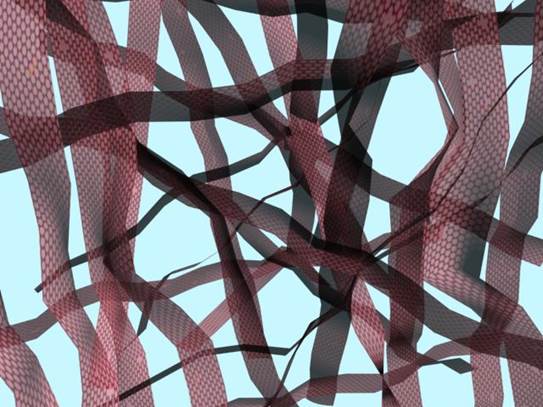Unzipped nanotubes as an alternative to costly platinum for fuel cells
March 4, 2015

This illustration shows a three-dimensional aerogel created by researchers at Rice University who combined graphene nanoribbons with boron and nitrogen. The aerogels show promise as a possible alternative to expensive platinum in fuel cells. (credit: Ajayan Group/Rice University)
Rice University researchers have formed graphene nanoribbons into a three-dimensional aerogel enhanced with boron and nitrogen as catalysts for fuel cells as a replacement for platinum.
In tests involving half of the catalytic reaction that takes place in fuel cells, a team led by materials scientist Pulickel Ajayan and chemist James Tou discovered that versions with about 10 percent boron and nitrogen were efficient in catalyzing an “oxygen reduction reaction” — a step in producing energy from feedstocks like methanol.
The research appeared in the American Chemical Society journal Chemistry of Materials. The reactions in most current fuel cells are catalyzed by platinum, but platinum’s high cost has prompted the search for alternatives, Ajayan said.
Ajayan’s Rice lab has excelled in turning nanostructures into macroscopic materials, like the oil-absorbing sponges invented in 2012 or, more recently, solid nanotube blocks with controllable densities and porosities. The new research combines those abilities with the Tour lab’s 2009 method to unzip nanotubes into conductive graphene nanoribbons.
Graphene edges are where the action is
As KurzweilAI has reported, researchers have come to realize that graphene’s potential as a catalyst doesn’t lie along the flat face but along the exposed edges, where molecules prefer to interact. The Rice team chemically unzipped carbon nanotubes into ribbons and then collapsed them into porous, three-dimensional aerogels, simultaneously decorating the ribbons’ edges with boron and nitrogen molecules.
The new material provides an abundance of active sites along the exposed edges for oxygen reduction reactions. Fuel cells turn hydrogen (or sources of hydrogen like methane) into electricity. The primary waste products for methanol are carbon dioxide and for hydrogen, just water.
Abstract of Boron- and nitrogen-substituted graphene nanoribbons as efficient catalysts for oxygen reduction reaction
We show that nanoribbons of boron- and nitrogen-substituted graphene can be used as efficient electrocatalysts for the oxygen reduction reaction (ORR). Optimally doped graphene nanoribbons made into three-dimensional porous constructs exhibit the highest onset and half-wave potentials among the reported metal-free catalysts for this reaction and show superior performance compared to commercial Pt/C catalyst. Furthermore, this catalyst possesses high kinetic current density and four-electron transfer pathway with low hydrogen peroxide yield during the reaction. First-principles calculations suggest that such excellent electrocatalytic properties originate from the abundant edges of boron- and nitrogen-codoped graphene nanoribbons, which significantly reduce the energy barriers of the rate-determining steps of the ORR reaction.